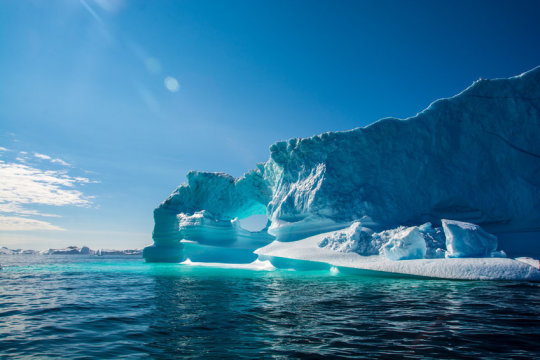[ad_1]
Carbon released into the atmosphere by the increasing loss of Arctic permafrost, combined with higher solar absorption by Earth’s surface due to the melting of sea ice and land snow, will accelerate climate change — and have a multi-trillion dollar impact on the world economy.
A new paper in Nature Communications reveals a combination of these factors has the potential to increase the long-term economic impact of climate change by just under $70 trillion, under mitigation levels consistent with current national pledges to cut carbon emissions (5% of the estimated total cost of climate change for this scenario).
Under the Intergovernmental Panel on Climate Change (IPCC) Paris Agreement target of global temperature rises being limited to 1.5C from pre-industrial levels, the extra impact drops to $25 trillion (4% of the total cost for this scenario). In both cases, the primary driver behind the additional costs is the emitted permafrost carbon.
The interdisciplinary research team hope their assessments will provide a better understanding of the socio-economic risks from climate change under different scenarios and help guide policy-makers towards prudent decisions on emissions reduction targets.
Researchers explored simulations of complex, state-of-the-art, physical models to quantify the strength of the permafrost carbon feedback (PCF), driven by the additional carbon released from thawing permafrost, and of the surface albedo feedback (SAF), driven by the extra solar energy absorbed by Earth’s surface as the white sea ice and land snow cover declines, exposing darker ocean and land.
Nearly all climate policy studies to date have implied a constant SAF and zero PCF. However, recent observations and computer models show the permafrost feedback is the stronger of the two and that both are nonlinear, their strength changing in complex ways as the climate warms. This affects their impact on both the global climate and economy.
“Arctic sea ice and land snow currently contribute around a third each to the global albedo feedback,” said lead author Dmitry Yumashev, of the Pentland Centre for Sustainability in Business at Lancaster University.
“These two components are set to peak for global temperatures within the range covered by the Paris Agreement, but if the climate warms further, the summer and spring sea ice and land snow covers will retreat further north and the albedo feedback will actually weaken.
“The permafrost feedback, however, grows progressively stronger in warmer climates. Both feedbacks are characterised by nonlinear responses to warming, including a varying lag between rising global temperature and permafrost carbon emissions.
“Compared with zero PCF and constant SAF from present-day climate — legacy values used in climate policy modelling to this point — the combined nonlinear PCF and SAF cause significant extra warming globally under low and medium emissions scenarios.
Low emissions scenarios in the study include meeting the 1.5°C and 2°C Paris Agreement targets relative to pre-industrial conditions by 2100, while medium emissions scenarios include mitigation levels consistent with current national pledges (NDCs). Under the NDCs, the world is set to warm by around 3°C relative to pre-industrial by 2100.
High emissions scenarios, such as the current business as usual trajectory (BaU) — expected to lead to around 4°C of warming by 2100 and cause by far the highest impacts on ecosystems and societies — are also included. Under these, the strength of the PCF reaches its peak and does not increase further, while the continued weakening of the SAF gradually cancels the warming effect of the PCF.
For the purposes of the research, other major planetary feedbacks, such as those driven by changes in clouds and water vapour in response to warming, are assumed to remain constant, supported by the last two generations of climate models.
Under all scenarios, using the nonlinear Arctic feedbacks compared to previous constant values leads to an increase to the total cost of climate change, consisting of the mitigation costs of cutting emissions, climate adaptation costs and residual climate-related impacts. The increases occur primarily through additional temperature-driven impacts on economy, ecosystems and human health, and additional impacts from sea level rise.
All costs were estimated using simulations in specially developed integrated assessment model PAGE-ICE, which includes simple statistical representations of the Arctic feedbacks derived from complex models. It has multiple updates to climate science and economics, including up-to-date uncertainty estimates.
Under the NDCs scenario, the additional estimated impact based on thousands of simulations of the nonlinear PCF and SAF is just under $70 trillion compared to their previously used values — exceeding by around 10 times current estimates for long-terms economic gains from transit shipping routes and mineral resource extraction in the Arctic region.
With previous estimates for Arctic feedbacks, the total cost of climate change associated with the 1.5C and 2C scenarios is virtually the same and is around $600 trillion — in comparison, the estimated cost of business as usual is around $2000 trillion. Nonlinear PCF and SAF add further $25 trillion to the $600 trillion figure for the 1.5C scenario and $34 trillion for the 2C scenario. Thus, the nonlinear Arctic feedbacks make the more ambitious 1.5C target marginally more economically attractive.
Dr Yumashev added: “Our findings support the need for more proactive mitigation measures to keep global temperature rise well below 2C.
“We hope our work will lead to further assessments of multiple nonlinear processes in the Earth’s climate system, both those associated with the Arctic and beyond.”
The authors of the study are Dmitry Yumashev, Gail Whiteman and Paul Young, of the Pentland Centre for Sustainability in Business and Lancaster Environment Centre at Lancaster University; Chris Hope, of the Judge Business School at the University of Cambridge; Kevin Schaefer, of the National Snow and Ice Date Center at the University of Colorado (USA); Kathrin Riemann-Campe, of the Alfred Wegener Institute (Germany); Fernando Iglesias-Suarez, of the Institute of Physical Chemistry Rocasolano (Spain); Elchin Jafarov, of the Los Alamos National Laboratory (USA); Eleanor J. Burke, of the UK Met Office; and Yasin Elshorbany, of the University of South Florida (USA).
[ad_2]















